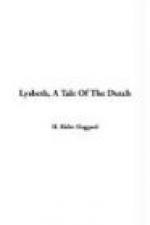Behind her lay the roofs of Leyden, pointed, picturesque, and covered with sheets of snow, while above them towered the bulk of the two great churches of St. Peter and St. Pancras, and standing on a mound known as the Burg, the round tower which is supposed to have been built by the Romans. In front stretched the flat expanse of white meadows, broken here and there by windmills with narrow waists and thin tall sails, and in the distance, by the church towers of other towns and villages.
Immediately before her, in strange contrast to this lifeless landscape, lay the peopled mere, fringed around with dead reeds standing so still in the frosty air that they might have been painted things. On this mere half the population of Leyden seemed to be gathered; at least there were thousands of them, shouting, laughing, and skimming to and fro in their bright garments like flocks of gay-plumaged birds. Among them, drawn by horses with bells tied to their harness, glided many sledges of wickerwork and wood mounted upon iron runners, their fore-ends fashioned to quaint shapes, such as the heads of dogs or bulls, or Tritons. Then there were vendors of cakes and sweetmeats, vendors of spirits also, who did a good trade on this cold day. Beggars too were numerous, and among them deformities, who, nowadays, would be hidden in charitable homes, slid about in wooden boxes, which they pushed along with crutches. Lastly many loafers had gathered there with stools for fine ladies to sit on while the skates were bound to their pretty feet, and chapmen with these articles for sale and straps wherewith to fasten them. To complete the picture the huge red ball of the sun was sinking to the west, and opposite to it the pale full moon began already to gather light and life.
The scene seemed so charming and so happy that Lysbeth, who was young, and now that she had recovered from the shock of her beloved father’s death, light-hearted, ceased her forward movement and poised herself upon her skates to watch it for a space. While she stood thus a little apart, a woman came towards her from the throng, not as though she were seeking her, but aimlessly, much as a child’s toy-boat is driven by light, contrary winds upon the summer surface of a pond.
She was a remarkable-looking woman of about thirty-five years of age, tall and bony in make, with deep-set eyes, light grey of colour, that seemed now to flash fiercely and now to waver, as though in memory of some great dread. From beneath a coarse woollen cap a wisp of grizzled hair fell across the forehead, where it lay like the forelock of a horse. Indeed, the high cheekbones, scarred as though by burns, wide-spread nostrils and prominent white teeth, whence the lips had strangely sunk away, gave the whole countenance a more or less equine look which this falling lock seemed to heighten. For the rest the woman was poorly and not too plentifully clad in a gown of black woollen, torn and stained as though with long use and journeys, while on her feet she wore wooden clogs, to which were strapped skates that were not fellows, one being much longer than the other.




